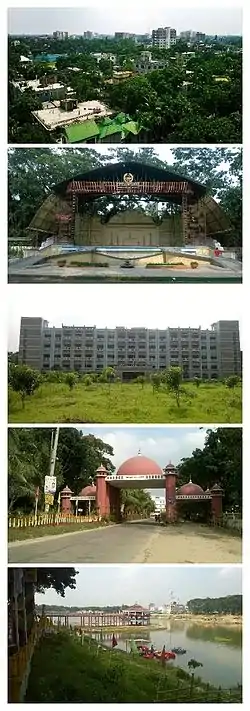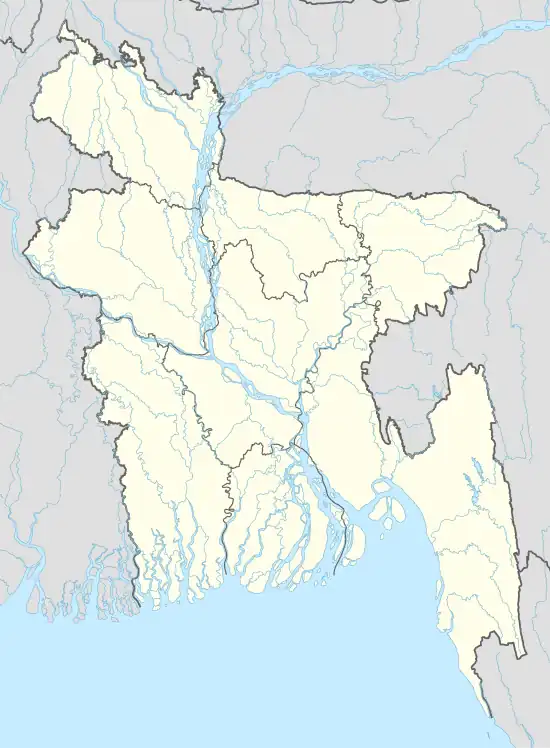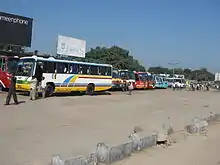Tangail
টাঙ্গাইল | |
|---|---|
City | |
 From top to bottom: 1. The city skyline from "Suparibagan"; 2. The Open Stage of Tangail Poura Uddan; 3. Tangail District Court Building; 4. The city gate, Shamsul Huq Toron"; 5. DC Lake at District Headquarters | |
 Tangail Location of Tangail in Bangladesh  Tangail Tangail (Bangladesh) | |
| Coordinates: 24°15′52″N 89°55′05″E / 24.264423°N 89.918140°E | |
| Country | Bangladesh |
| Division | Dhaka Division |
| District | Tangail District |
| Upazila | Tangail Sadar Upazila |
| Incorporated | 1969 |
| Government | |
| • Type | Pourashava |
| • Mayor | Sirajul Haque Alamgir (Bangladesh Awami League) |
| Area | |
| • Total | 29.04 km2 (11.21 sq mi) |
| Elevation | 14 m (46 ft) |
| Population (2016)[1] | |
| • Total | |
| Time zone | UTC+6 (BST) |
| Postal codes | 1900, 1901, 1902 |
| Area code | 0921 |
| Website | tangailpourashava |
| [2] | |
Tangail (Bengali: টাঙ্গাইল, [ʈaŋgail]) is a city of Tangail District in central Bangladesh.[3] Tangail is a significant city in Bangladesh. It lies on the bank of the Louhajang River,[4] 83 kilometres (52 mi) northwest of Dhaka, the nation's capital.[5] It is the 25th most populous city in Bangladesh.[6]
Etymology
Tangail originates from the Bengali word tanga, meaning horse carts; long lines of horse carts were standard in the area in the early 19th century,[7] as these were the favoured mode of transport for passengers and cargo.[8]
History
Tangail has been a local business center since the early 19th century.[9] In 1860, Tangail became the 4th ranking area of the Greater Mymensingh district due to its fertile land near the Louhajong River. It was close to Begun Bari, Mymesningh. In 1969, Tangail district was established.
Tangail Airdrop
The Tangail Airdrop was a successful battalion-size operation by India's Para Commandos, mounted on December 11, 1971, by the 2nd Battalion (Special Operations) (2 PARA) of the Indian Army's Parachute Regiment during the Indo-Pakistani War of 1971 for the liberation of Bangladesh. The operation's main objective was capturing Poongli Bridge on the Jamuna River, which would cut off the Pakistani 93rd Brigade, which was retreating from Mymensingh in the north to defend the capital of East Pakistan, Dhaka, and its approaches. The paratroop unit was also tasked to link up with the advancing Maratha Light Infantry on the ground to advance toward the East Pakistani capital.
The Pourasabha (municipal corporation) was established on July 1, 1887, and initially divided the city into five wards:
| Ward No. | Area |
|---|---|
| 1 | Tangail Kanda Para, Par Dighulia, Akur Takur Para |
| 2 | Korer Betka, Mirer Betka, Nondir Betka, Sabalia, Dorun, Ashekpur, Nagor Jalfai, Boali |
| 3 | Garai, Berai, Kazipur, Bachrakandi, Potol, Bajitpur, Berabuchna, Valluk kandi |
| 4 | Kagmari, Sontosh, Aloa, Boitta, Patuli, Ekrampur |
| 5 | Kalipur, Dighulia, Sakrail, Kaiyamara, Beradoma, Basha, Khanpur |
This was later restructured into four wards - Ward No. 1 (Central), 2 (Betka), 3 (Dighulia), and 4 (Santosh) - and then, in 1988, into six wards with the addition of Wards 5 (Zila Sadar) and 6 (Kazipur).
The first city election was held in November 1887 when the citizens elected eight ward commissioners from four wards. The Subdivision Commissioner of Tangail, Shashi Shekhar Dutt, was appointed as the first administrator of Tangail City. The city needed to be better developed, lacking paved roads and roadside lamps; subsequently, the regional zamindars and subdivision board provided financial support to dig ponds, lakes, and canals, creating a safe water supply.[10]
Electricity was established in the city in the early 1930s. Paved roads were constructed in the 1960s, connecting the town to Dhaka. Simultaneously, bridges and culverts were installed.[11]
In 1985, Tangail was promoted from a C to a B Class city. In 1989, the Pourashava was promoted to A-Class. In the 1990s, the city was financed by the Asian Development Bank and the Government of Bangladesh to develop water supply, sanitation, wastewater drainage, bus terminals, supermarkets, and other infrastructure.[12]
In 1999, the city was restructured again into 18 wards (its current organization).[13]
Wards
Tangail has an area of 35.22 square kilometres (13.60 sq mi), divided into 18 wards and 64 mahallas.[14]
| Ward No. | Region | Households | Population (2011) |
|---|---|---|---|
| 1 | Akur Takur Para-north, Dewla, District hq | 2070 | 10388 |
| 2 | Enayetpur | 2142 | 8760 |
| 3 | West Akur Takur Para, North Kagmara, South Kagmara | 3205 | 13903 |
| 4 | Bepari Para, Fakir Para, Bera Doma, Dighulia, Char Dighulia | 2119 | 9208 |
| 5 | Kalipur, Lakshimpur, Sarutia, Shakrail | 1614 | 7235 |
| 6 | College Para, Paradise Para, Par Dighulia-part | 1569 | 6712 |
| 7 | Baluk Kandi, Bagbari, Patuli Bhabani Bagbari, Uttar Santosh-part, Santosh Palpara | 1674 | 7325 |
| 8 | Aloa Bhabani Pahim, Aloa Pahim, Dakshin Santosh-part | 1797 | 8026 |
| 9 | Aloa Baratia, Aloa Paikasta, Aloa Tarini, Baluk Kandi-part, Char Patuli, Purba Aloa, Aloa Bhabani | 1888 | 8575 |
| 10 | Bajitpur, Berai, Basrakandi, Kazipur, Patal | 1458 | 6189 |
| 11 | Berabuchna, Kachua Para, Kanda Para | 1929 | 7536 |
| 12 | Adi Tangail, Bepari Para, Bil Para | 1628 | 7160 |
| 13 | Tangail Mahalla, Chayanir Bazar, Pachanir Bazar, Thana Para, Uttar Thana Para | 1792 | 7572 |
| 14 | Purba Adalat Para, Adalat Para, Biswas Betka-part S.W corn, Shaha Para | 2790 | 11786 |
| 15 | Ashekpur, Biswas Betka-part | 2745 | 12118 |
| 16 | Akur Takur Para-part, Par Dighulia-part | 2459 | 10670 |
| 17 | Kumudini College Para, Munshi Para, Registry Para, Biswas Betka-west | 2128 | 11081 |
| 18 | Kodalia, Sabalia | 2600 | 13168[15] |
The Bangladeshi government is planning to expand the city to a total area of 81.75 km2.
Geography and climate
The city of Tangail is in Dhaka Division, Central Bangladesh. The town lies in a low-lying floodplain near the Jamuna River, south of the high plateau of the Madhupur tract. The average elevation of Tangail is 14 meters (49 feet).[16] Tangail experiences a Tropical savanna climate(Köppen: Aw ) with a hot, humid tropical wet season (monsoon season) and warm, dry winter with high humidity year-round. The yearly average temperature in Tangail is 27.5 °C, and the average rainfall is 1817 mm.
| Month | Jan | Feb | Mar | Apr | May | Jun | Jul | Aug | Sep | Oct | Nov | Dec | Year |
|---|---|---|---|---|---|---|---|---|---|---|---|---|---|
| Mean daily maximum °C (°F) | 23.9 (75.0) |
27.5 (81.5) |
31.7 (89.1) |
33.9 (93.0) |
33.4 (92.1) |
32.7 (90.9) |
31.9 (89.4) |
32.2 (90.0) |
32.1 (89.8) |
31.7 (89.1) |
29.4 (84.9) |
26.0 (78.8) |
30.5 (87.0) |
| Mean daily minimum °C (°F) | 11.4 (52.5) |
14.4 (57.9) |
18.9 (66.0) |
22.8 (73.0) |
24.0 (75.2) |
25.6 (78.1) |
26.1 (79.0) |
26.3 (79.3) |
25.7 (78.3) |
23.5 (74.3) |
18.5 (65.3) |
13.5 (56.3) |
20.9 (69.6) |
| Average rainfall mm (inches) | 6.1 (0.24) |
27.0 (1.06) |
43.8 (1.72) |
110.7 (4.36) |
253.5 (9.98) |
317.6 (12.50) |
323.8 (12.75) |
243.0 (9.57) |
287.8 (11.33) |
166.0 (6.54) |
26.2 (1.03) |
11.6 (0.46) |
1,817.1 (71.54) |
| Average relative humidity (%) | 80 | 74 | 69 | 74 | 79 | 84 | 85 | 85 | 85 | 83 | 80 | 81 | 80 |
| Source: Bangladesh Meteorological Department[17][18][19] | |||||||||||||
Demographics
Tangail had 167,412 residents as of 2011. 18.45% were under the age of 10.
Most of this population is Muslim (88.11%), like most of the cities in Bangladesh. Other religious groups include Hindus (11.80%), Christians (0.08%), and Buddhists (0.01%).
Sports
At the city's centre, the multipurpose Tangail Stadium regularly hosts sporting events.[21] The stadium has hosted national events.
Transport

Bangabandhu Bridge, the second longest bridge in Bangladesh, connects Tangail and Sirajganj.[22]
It takes approximately 1 hour and 55 minutes to reach Tangail from Dhaka (about 98 km away) via Kaliakair and Tongi. Several bus lines operate between Tangail and Dhaka's Mohakhali (মহাখালী) bus terminal. The Nirala, Dhaleshwari, Jathika, and High Choice bus lines are among them.
Tangail railway station offers travel to Dhaka and other cities within Bangladesh. The inter-city Ekota Express, Sundarban Express, Rangpur Express, Intercity Tangail Commuter and Sirajganj Express (amongst others) serve the station alongside commuter rail and mail train services.[23]
Tangail Airport was opened in 1967 for agricultural purposes but has been unmaintained since 1976.
Traditional foods
Parks
Tangail contains numerous parks, including Tangail Poura Uddan (one of the city's most-visited places), DC Lake, SP Park, and Soul Park. The town also contains part of the Madhupur National Park, one of Bangladesh's oldest national parks.
Education
Schools
- Bindu Basini Govt. Boys' High School (established in 1880 by zamindar of Santosh of the famous Roy Chowdhury family)
- Bindu Basini Govt. Girls' High School (established in 1882 by zamindar of Santosh of the famous Roy Chowdhury family)
- Govt. Dhanbari Nawab Institution (Established in 1910 by Syed Nawab Ali Chowdhury) famous zamindar of Dhanbari. He is also a founder member of Dhaka University
- Miyavai International School and College, Madhupur (This school was established on 2.2.22 (2 February 2022) by Boro Miya (Miya vai/Rasel Miya) of the famous Miya family of Madhupur.)
- Police Lines High School
- Sristy College Of Tangail
- Tangail Polytechnic
- Santosh Jannabi Govt. High School
- Vivekananda High School
- Madhupur Shaheed Smriti Higher Secondary School & College, Madhupur
- Gvt.Rani Bhavani Pilot High School, Madhupur
- A.R.L Memorial School and College,Madhupur
- Bharateshwari Homes, Mirzapur
- B.A.F Shaheen College, Pahar Kanchanpur
- Zila Sadar Girls' High School
- Shibnath High School
- P.T.I. High School
- Shaheen School and College
- Bulbul Residential Model School, Tangail Sadar, Tangail
- Athail Shimul High School Ghatail Tangail
- Brammon Kushia Government Primary School, Brammon Kushia, Tangail
- Bararia Suruj Bisweswari High School, Bararia, Tangail
- Apon Pathshala, Tangail
- Ghatail Cantonment Public School & College.
- Suti V.M Pilot High School, Gopalpur
Higher education
- Mawlana Bhashani Science and Technology University, Santosh, Tangail
- Sheikh Hasina Medical College, Tangail
- Kumudini Women's Medical College, Mirzapur
- Mirzapur Cadet College
- Major General Mahmudul Hassan Adarsha College
- Sristy College of Tangail
- Madhupur Shahid Smrity Higher Secondary School & College, Madhupur
- Kumudini Government Mohila College
- GRB University, Madhupur (Recommended)
- A.R.L Memorial School and College
- Hazi Giyash Uddin Medical College, Madhupur
- Madhupur Assistant Medical Training Centre
- Govt. Sheikh Fazilatunnesa Mujib Mohila College
- Tangail Polytechnic Institute
- Vivekananda College
- B.A.F Shaheen College, Pahar Kanchanpur
- Govt. Saadat College, Karatia
- Bangabandhu Textile Engineering College,(BTEC) Kalihati
- Textile Institute of Tangail
- M.M Ali College
- Haji Abul Hossain Institute of Technology
Notable residents
- Syed Nawab Ali Chowdhury, Zamindar, founding member of University of Dhaka, education minister of United Bengal
- Maulana Abdul Hamid Khan Bhashani, Islamic scholar, political leader, and ex-president of the Awami League.
- Shamsul Huq, the first general secretary of the Awami League.
- Abu Sayeed Chowdhury, the second president of Bangladesh.
- Abdul Mannan, the Home and Family Planning Minister (1972-1975), MNA (1970), MP (1996-2001). He established the Tangail General Hospital, Govt. Sheikh Fazilatunnesa Mujib College, and Atia College.
- Qader "Tiger" Siddiqi, Pakistan Army havildar, famed Mukti Bahini leader (decorated Bir Uttom) (MP 1999–2013), and founding leader of Krishak Sramik Janata League.
- Mohammad Abdur Razzaque, Member of Parliament from Tangail-1
- Soto Monir, Member of Parliament from Tangail-2
- SM Aslam Talukder aka Manna, film actor and producer.
- Tarana Halim, M.P., film actress
See also
References
- ↑ "Tangail · Population". Population.city.
- ↑ "Population Census 2011: National Volume-3: Urban Area Report" (PDF). Bangladesh Bureau of Statistics. p. 8. Retrieved 31 January 2016.
- ↑ mcFee, James (21 April 2017). City Maps Tangail Bangladesh. Soffer Publishing.
- ↑ "Land grabbers choke Tangail's louhajong river". The Daily Star Bangladesh. 30 June 2015. Retrieved 13 February 2016.
- ↑ "Tangail | Bangladesh". Encyclopedia Britannica. Retrieved 18 September 2020.
- ↑ "Population of Cities in Bangladesh 2023". worldpopulationreview.com. Retrieved 16 June 2023.
- ↑ "Tangail Trip Planner". Inspirock. Retrieved 25 October 2020.
- ↑ shakhawat@@0708 (9 June 2022). "Tangail DC Office Job Circular 2021". Sarkari Niyog. Retrieved 14 March 2023.
{{cite web}}: CS1 maint: numeric names: authors list (link) - ↑ "Porabarir Chomchom goes international, puts Tangail on the map". Dhaka Tribune. 19 December 2019. Retrieved 25 October 2020.
- ↑ Crelis, Rammelt. "The Waterways of Tangail: Failures to Learn from Flood-Control Efforts in the Brahmaputra Basin of Bangladesh". Water Alternatives. 22 (1).
- ↑ Blankespoor, Brian. "Bridge to Bigpush or Backwash? Market Integration, Reallocation, and Productivity Effects of Jamuna Bridge in Bangladesh" (PDF). mpra.ub.uni-muenchen.de.
- ↑ "আমাদের কথা". tangailpourashava.gov.bd. Retrieved 14 October 2020.
- ↑ Hosen, Elias. "Effect of Water Logging in Tangail Paurashava" (PDF). Journal of Science and Technology.
- ↑ "District LGED". oldweb.lged.gov.bd. Retrieved 25 October 2020.
- ↑ "Tangail Pourashava C01 P-97,98,99". Bangladesh Bureau of Statistics. 16 June 2011. Retrieved 11 January 2016.
- ↑ "Worldwide Elevation Finder". elevation.maplogs.com. Retrieved 6 July 2021.
- ↑ "Climate of Bangladesh" (PDF). Bangladesh Meteorological Department. pp. 19–23. Archived from the original (PDF) on 24 December 2018. Retrieved 24 December 2018.
- ↑ "Normal Monthly Rainy Day" (PDF). Bangladesh Meteorological Department. Archived from the original on 9 July 2017. Retrieved 24 December 2018.
- ↑ "Normal Monthly Humidity" (PDF). Bangladesh Meteorological Department. Archived from the original on 24 December 2018. Retrieved 24 December 2018.
- ↑ "Bangladesh Bureau of Statistics Region Census 2011". Bangladesh Bureau of Statistics. Retrieved 20 September 2014.
- ↑ "Tourneys uncertain due to slow pace of renovation". The Daily Star. 5 June 2013.
- ↑ "Bangabandhu Jamuna Multipurpose Bridge". Banglapedia. Retrieved 14 September 2020.
- ↑ "Train schedule of Tangail station" (in Bengali). Bangladesh Railway. 1 June 2001.